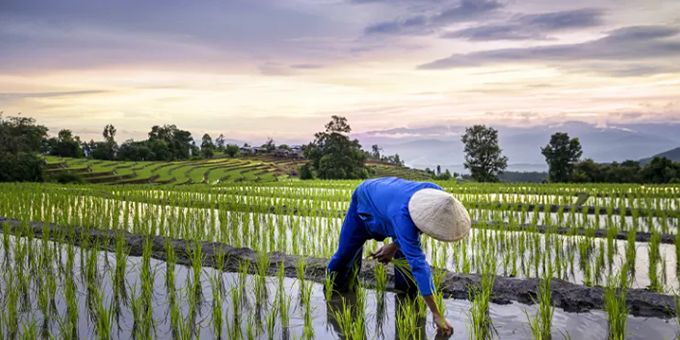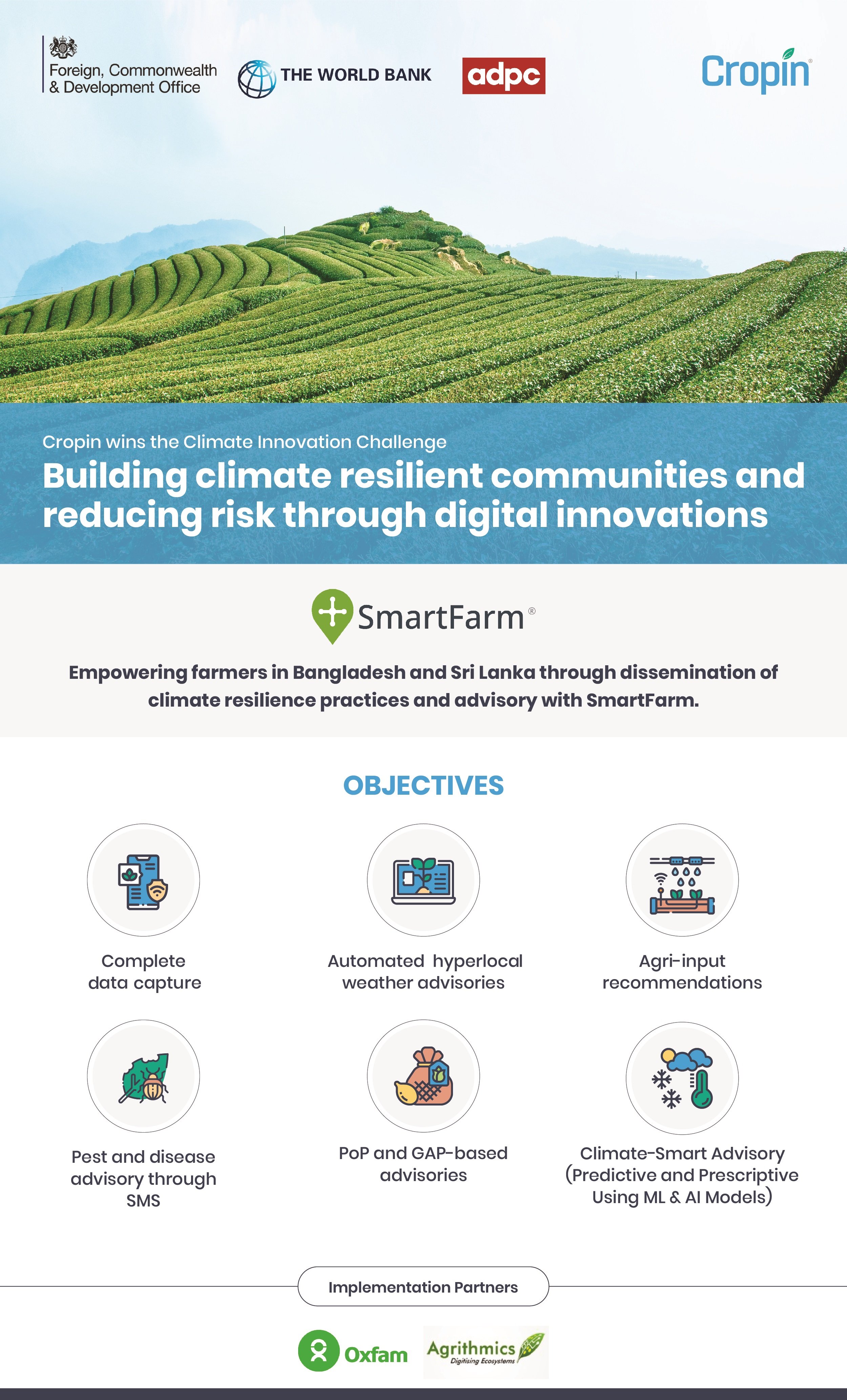Climate risks can directly affect crop production by reducing agricultural yields for some crops, increasing production volatility, and destabilising farmer incomes. On the one hand, oversupply could result in farmers receiving lower profits.
 Enhancing Climate Adaptation and Resilience in South Asia
Enhancing Climate Adaptation and Resilience in South Asia

Article from | Cropin
Parts of Asia may face climate risks, including rising average temperatures, extreme precipitation events, fatal heat waves, devastating hurricanes, and severe drought by 2050, which would have an adverse impact on the agriculture sector. Without adequate resilience and climate adaptation, the economies and communities in this region will be increasingly prone to these risks.
Climate risks can directly affect crop production by reducing agricultural yields for some crops, increasing production volatility, and destabilizing farmer incomes. On the one hand, oversupply could result in farmers receiving lower profits. On the other hand, under-supply could lead to food shortages and price spikes.
A long-term solution was the need of the hour to support countries in Asia and the Pacific to mitigate disaster and climate risk impacts. Hence, the Asian Disaster Preparedness Center (ADPC) implemented the Climate Adaptation and Resilience for South Asia or CARE for South Asia project to support local communities in building climate resilience. What followed was the Climate Innovation Challenge (CIC), a sub-component of the CARE for South Asia project.
Cropin Wins the Climate Innovation Challenge
Following careful consideration of nearly 240 applications from around the world, an independent jury of experts chose SmartFarm as a winning innovation with the potential and proven experience to achieve the core objectives in Sri Lanka and Bangladesh.
In December 2021, we began deploying a tailored advisory dissemination system through our ICT platform, SmartFarm. It will enable smallholder farmers to have increased access to knowledge and information on sustainable best practices along with curated, timely, and automated weather advisories for climate adaptation and resilience.

For Cropin, partnerships are central to scaling our solutions and making them more accessible for local beneficiaries globally. To ensure the maximum reach in the two countries, we collaborated with our local partners in both Bangladesh and Sri Lanka.
In Bangladesh, Oxfam will support the implementation through its robust network of 40 partners and around 300 community-based organizations in 20 districts. They have a significant presence in southwestern and northern parts of Bangladesh, working with over 30,000 farmers, especially women. Besides promoting climate-resilient agricultural practices, this project will also benefit Oxfam’s implementation of its Climate Risk Insurance products.
Agrithmics in Sri Lanka is one of the agritech startup forerunners, backed by Dialog Axiata. The company provides tech and fin-tech solutions to digitize the last-mile agriculture in the country. Agrithmics operates in several regions and boasts of a massive umbrella of 50,000 registered farmers.
Leveraging ICT to Enhance Climate Adaptation and Resilience
Smallholder farmers are particularly vulnerable to the impact of climate change. A primary challenge they face in this regard is the lack of access to timely information, which can help them protect their crops, land, and livestock from extensive damage.
A practical way to improve access to advisories for climate-resilient and sustainable cultivation is to take advantage of the existing infrastructure. In most parts of the world, mobile phones are a common occurrence, even in remote locations. Hence, leveraging our tried-and-tested ICT platform to communicate and support knowledge exchange was our go-to course to deliver tailored advisory services to individual farmers at scale. We use SMS as our advisory dissemination channel for a wider reach while tailoring the messages to individual farm needs. This channel can also be a means to promote awareness of climate change and the need for resilience.
For the pilot of this project, Lead Farmers (men and women) will be identified within the farming community, who will guide and counsel the farmers assigned to them. Equipped with SmartFarm’s mobile application, they can capture on-ground, farm-level data related to each farmer, like mobile number, crops grown, acreage, date of sowing/pruning, and geo-coordinates.
We will then send curated advisories based on the information captured to the mobile app and the farmers’ registered mobile numbers. Our advisory services will include:
- POP and Good Agricultural Practice-based advisories
- Automated hyper-local weather advisories
- Crop-specific recommendations for the appropriate usage of fertilizers and chemicals
- Pest and disease advisory through SMS
- Climate-smart advisory (predictive and prescriptive using AI/ML models)
SmartFarm uses various data inputs to provide curated, timely, and automated weather advisories to farmers and farming communities. Here is an example of how such advisories will assist them to be climate smart. On a fine morning, the weather forecast suggests inadequate precipitation in the region over the next four days. Our rule-based advisory will then prescribe irrigation to crops that require it to ensure their productivity is not affected due to a lack of water.
Cropin’s platform also includes a proprietary Disease Early Warning System. The prediction model finds a correlation between climatic conditions and crop-specific diseases to predict their chances of occurrence under certain environmental conditions. This capability is beneficial for farmers to avoid crop loss due to pests and diseases.
Empowering Farmers to Grow More and Grow Better
Our mission to maximize per-acre value drives us to design solutions to the challenges faced by the global agri-ecosystem. For this project, we also aim to achieve the below objectives through this project:
- Ensure that the features we deploy work in alignment with fulfilling the end goals of the CIC project
- Increase on-field productivity by reducing the time agripreneurs take for data capture
- Reduce crop losses and production costs by providing timely pesticide and fertilizer application advisories
- Enhance the livelihoods of farmers through better price realization post-harvest
- Increase the penetration of technological services to aid sustainable long-term growth for all stakeholders involved.
Our extensive practical experience providing early warning systems for 200+ projects globally allows us to learn as we grow. We have tailored solutions for various use cases, solving unique challenges and helping public and private organizations evolve using advanced agtech solutions.
The content & opinions in this article are the author’s and do not necessarily represent the views of AgriTechTomorrow
Comments (0)
This post does not have any comments. Be the first to leave a comment below.
Featured Product

